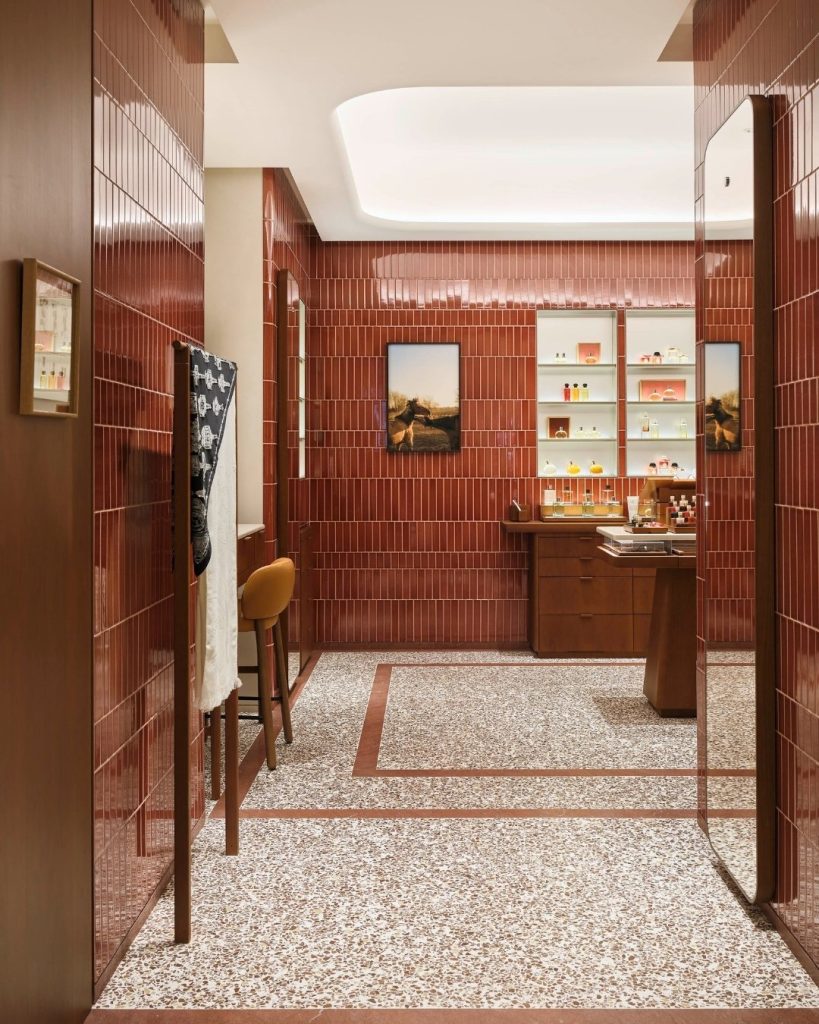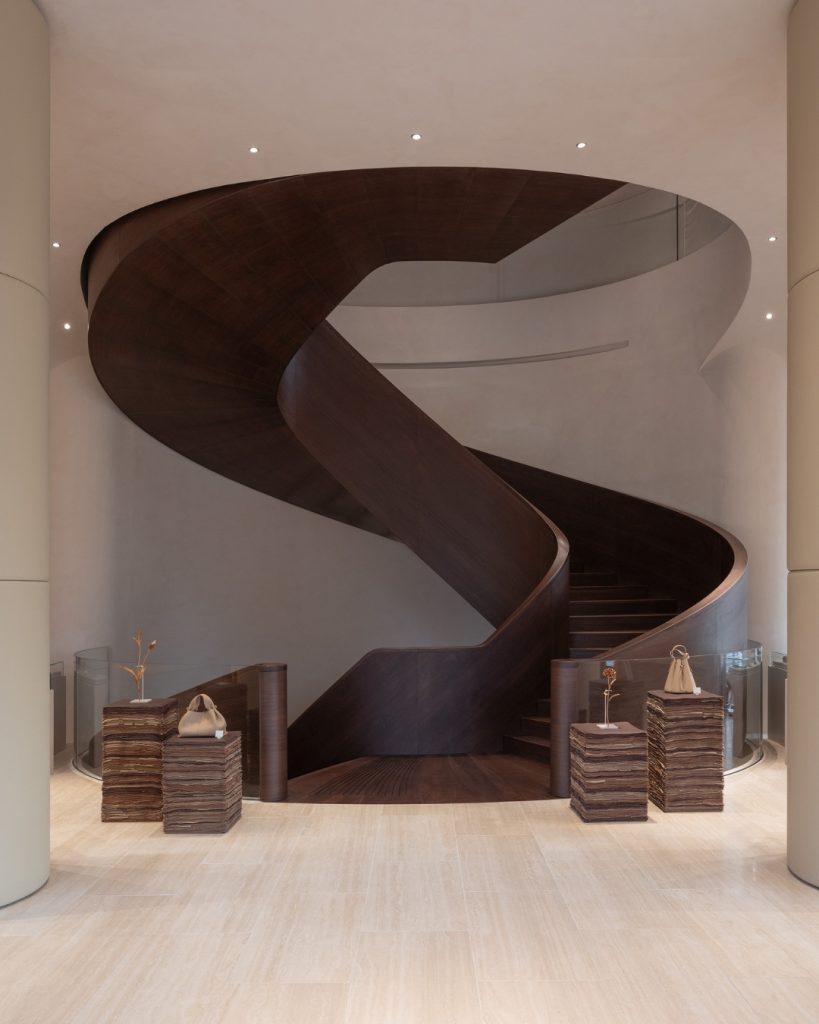
In an increasingly digital world, luxury fashion brands are strategically reinvesting in brick-and-mortar spaces, transforming them from mere points of sale into immersive sanctuaries. This move goes beyond traditional retail, leveraging ambitious architecture that embodies the brand image and curated permanent or pop-up art installations to create a powerful multi-sensory experience. Polène at the Champs-Élysées, for example, invites us on a journey from Paris to Ubrique—where the bags were crafted—spotlighting the craftsmanship honoured by the French leather brand.
These spaces are designed to be destinations in their own right, where the very walls, lighting, and layout communicate the brand’s ethos, telling a story that a two-step online transaction cannot. In fact, it’s becoming more common for travellers and fashion enthusiasts to take a pit stop at these immersive stores, adding these addresses to their itineraries.
This architectural strategy is a direct investment in a long-term brand narrative. By creating a tangible space, a brand solidifies its identity, fostering an emotional connection with shoppers that translates into loyalty. Eventually, these stores become cultural landmarks—like the historical Chanel’s store, 31 Rue Cambon—generating buzz that extends the brand’s reach far beyond their physical location. A store is no longer just a place to purchase a product, but a touchpoint to live and feel the brand’s universe.
Hermès

Via degli Strozzi, Florence
In the birthplace of the Renaissance, Hermès has set up a beacon of sophisticated design. The French luxury brand opened the doors to a two-floor store on Via degli Strozzi in Florence, in a building dating back to 1578. The store’s design, created by French architecture agency RDAI, honours the building’s history: elements of its Renaissance-era façade, including its vast windows, have been restored. Inside, more beautiful touches abound. The store greets you with Hermès’s gleaming ex-libris in metal on the floor. The main room, housing the maison’s silk scarves and fashion jewellery, is marked with the Faubourg pattern, while the beauty room is lined with terracotta-glazed tiles. Head up the majestic spiral staircase, featuring a leather-covered handrail, to discover even more of Hermès’s women’s offerings. The window displays—always a highlight of Hermès boutiques—currently showcase the works of Italian designer Andrea Mancuso, who recreated Florence’s architectural landmarks and Hermès’s horse and carriage motif in rattan.
Balenciaga

Taikoo Li Sanlitun, Beijing
Balenciaga’s four-storey flagship in Taikoo Li Sanlitun, Beijing, is a sight to behold. It’s impressive enough in figures: the Balenciaga store spans 1,204 square metres, making it the largest one in China. The monolith features the French fashion brand’s raw, industrial aesthetic, which was first conceptualised by former creative director Demna and executed by the Berlin-based architecture studio Gonzalez Haase AAS. The store’s clear, glazed exterior, concealed with weathered textiles, is a nod to the curtain wall façades of Beijing’s office buildings in the 2000s. Inside, the store boasts rave-worthy interiors with its textured concrete walls and exposed ceilings. The rooms, including a private shopping suite on the top floor, are furnished with recycled leather seats and aluminum shelves. Relief from the stark, monochromatic spaces can be found in a showcase of haute couture creations from Balenciaga’s archives, including a jewel green evening gown by founder Cristóbal Balenciaga.
Dior

Ploenchit district, Bangkok
Judging by the photos alone, you might mistake Dior’s new concept store in Bangkok for the brand’s flagship on 30 Avenue Montaigne. While its façade does reference the iconic Paris boutique’s architecture, the Dior Gold House sets itself apart with its golden exterior, as its name suggests. It is also surrounded by verdant gardens, honouring founder Christian Dior’s love for them. Inside, visitors can discover unique art installations by Thai artists and designers, including a stool with an imprint of an elephant’s footprint, created by Boonserm Premthada, and a golden recreation of a tuk-tuk vehicle made by Saran Yen Panya. Over at the Café Dior, guests can dine on sweet treats and cocktails conceived by chef Mauro Colagreco, against a spectacular bamboo backdrop created by Korakot Aromdee.
Polène

Champs-Élysées, Paris
Much to the relief of anyone who has endured the long lines outside Polène’s Richelieu store, the French brand has opened another Paris outpost at the famed Champs-Élysées district. The flagship store, standing at two stories high, houses Polène’s beloved leather bags, accessories and jewellery. Visitors will also be delighted by the store’s interiors, which was designed by WGNB, the South Korean architectural firm behind Polène’s stores in Seoul and London. Some striking touches include a table that was specially commissioned by Polène to showcase its jewellery. The table, created by French artist and architect Clémentine Debaere-Lewandowski, is adorned with 500 white stoneware pieces; each one is imprinted with the texture of rocks found near the brand’s workshops in Ubrique, Spain. Another nod to Polène’s craft heritage can be found on the tabletops, which are covered with leather off-cuts from the brand’s archives. Head up the spiral staircase to the second floor, where you will encounter Marianna Ladreyt’s impressive Magnum couch. The curved sofa was entirely handcrafted by the French designer using interwoven leather tubes. Between Polène’s leather bags and the store’s leather furnishings, there is plenty of artistry to admire.
Louis Vuitton

57th Street, New York City
Louis Vuitton doesn’t do things in half measures, and its temporary store in New York City is proof. While it refurbishes its flagship on Fifth Avenue, the French luxury brand is welcoming clients to its new store on 57th Street. The building, which boasts five storeys in all, is the brand’s largest store in the US. You’ll get a sense of its size right from the atrium, which features four towers of stacked Louis Vuitton trunks, with each tower standing at 16 metres tall. Aside from those sculptures, which were created by OMA architect Shohei Shigematsu, the store is also adorned with patterns made by Louis Vuitton’s collaborators, including artists Yayoi Kusama, Takashi Murakami and Stephen Sprouse. The store is the first in the US to house Louis Vuitton’s luxury chocolate shop, Le Chocolat Maxime Frédéric at Louis Vuitton, as well as the dining concept, Le Café Louis Vuitton. The latter, which also doubles as a library, sets the stage for Louis Vuitton’s new “culinary community” concept, which offers emerging local chefs the opportunity to be mentored by Arnaud Donckele and Maxime Frédéric. But back to shopping: Louis Vuitton’s wide range of offerings is located on the first, second and third floor. Up on the fifth floor, clients can enjoy an intimate shopping experience at the private salons—one of which leads to a secret loft-inspired room.
This story first appeared in the GRAZIA Malaysia October 2025 print edition.
READ MORE
Paris Hilton on Being The Face of The New Karl Lagerfeld Fall/Winter 2025 Campaign
Major Moves: Véronique Nichanian Steps Down From Hermès After 37 Years
Giuseppe Marsocci Named CEO of the Armani Group, Following Founder Giorgio Armani’s Passing
